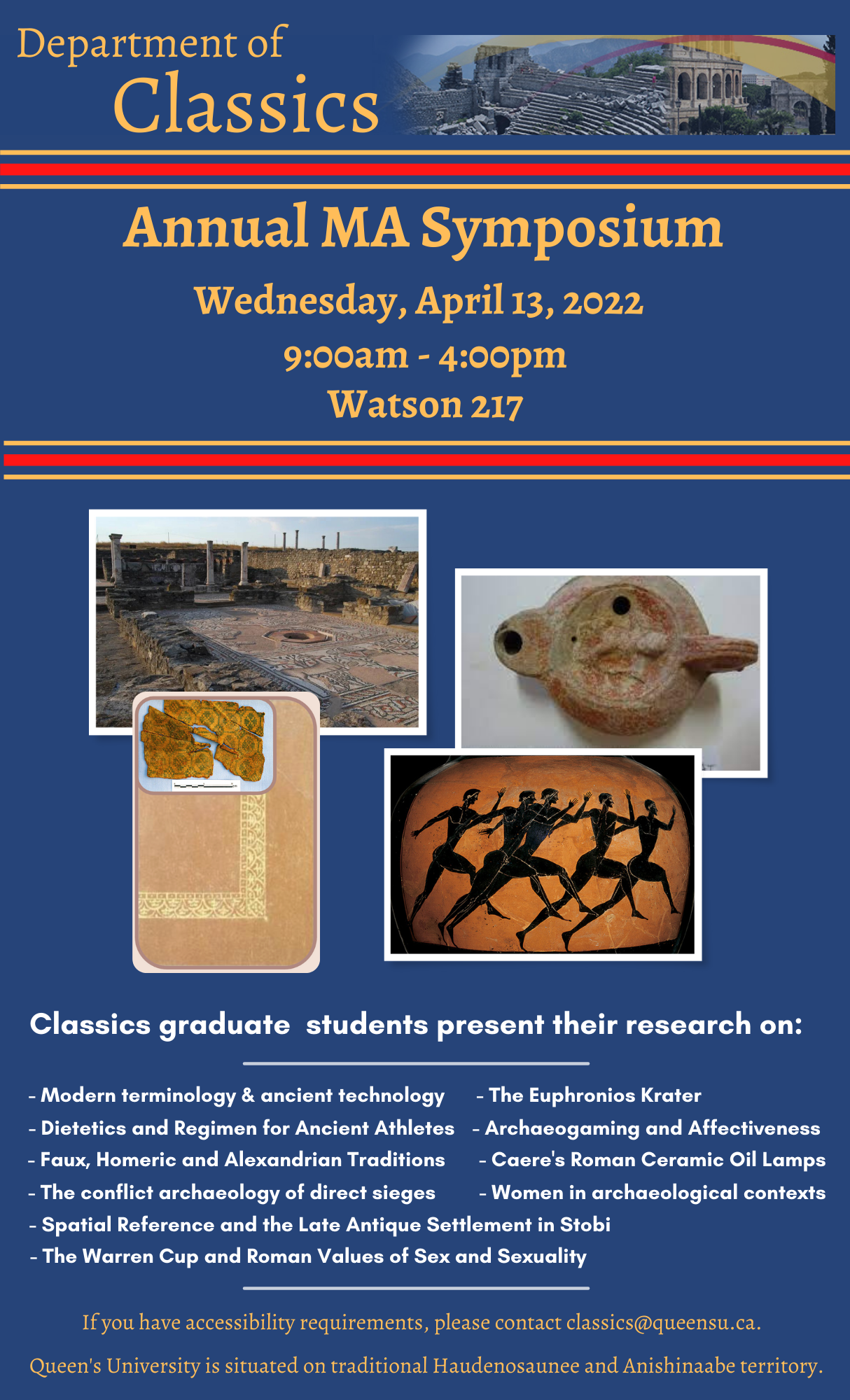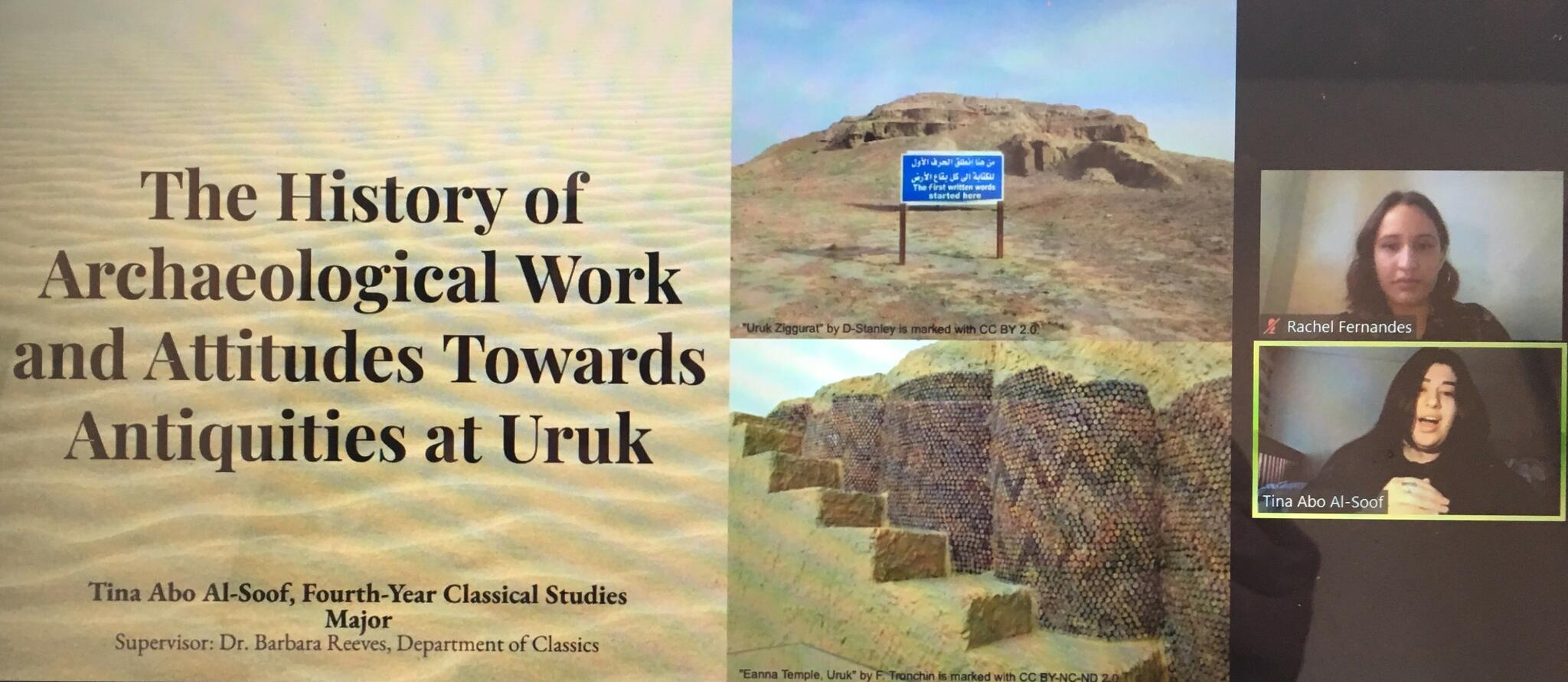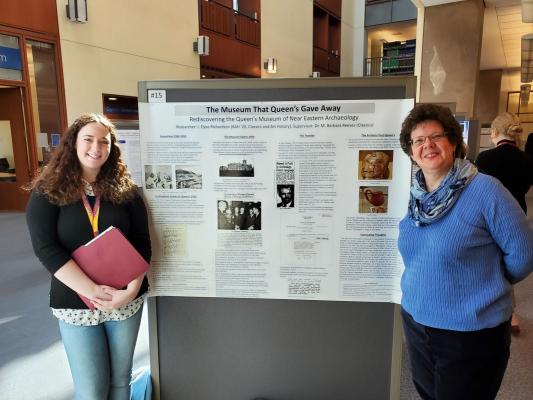2022
Classics MA Symposium - 13 April 2022

2022 Inquiry@Queen's
The History of Archaeological Work and Attitudes Towards Antiquities at Uruk
Presenter: Tina Abo Al-Soof
Faculty Supporter: Dr. Barbara Reeves
Uruk, also known as Warka, is an ancient Mesopotamian site in modern Iraq that has been the focus of archaeological exploration for over 165 years. Excavations at Uruk have revealed cultural remains from the Eridu period (ca. 5000 BCE) until the Parthian and Sasanian periods (ca. first and second centuries CE). The site is a key point of reference for understanding the development of early urbanisation, writing, architecture, production, and social structure. Over 165 years, changing politics, methods of archaeology and attitudes towards antiquities have affected the way the site was handled. My project focuses on those critical changes which reveal the evolution of archaeology from a Western-dominated affair to a more inclusive practice. In this presentation, I will discuss and evaluate the history of archaeological work and attitudes towards antiquities at Uruk with an emphasis on the teams that excavated there, their methods of excavation, the conditions of the permits they were given, and significant finds and their subsequent distribution. The analysis will be divided into historical time periods (from the Ottoman Period to Iraq after the US-led invasion of 2003) based on the modern history of this region. Governmental and professional policies are also explored in regard to antiquities laws, methods of archaeology and local versus foreign involvement.


2021 Inquiry@Queen's
Classics student Lilly Hickox (BAH '21) presented two projects at the annual Inquiry@Queen's (I@Q) Conference in March: one under the supervision of Dr. Barbara Reeves and the other with Dr. Cristiana Zaccagnino as supervisor.
In Light of the Lamps: A Comprehensive Analysis of the Ceramic Oil Lamps from the Roman Fort at Humayma
The archaeological site of Humayma, located at the northwest corner of the Hisma desert of Jordan, has a long history of permanent settlement; beginning with the Nabataeans, followed by Roman, Byzantine, and Islamic occupations. Shortly after Emperor Trajan’s conquest of the Nabataean Kingdom in 106 CE, a Roman fort emerged alongside the pre-existing trade route, which the Romans renamed the Via Nova Traiana.
Excavations at the fort, directed by J. P. Oleson in 1995, 1996, 2000, 2004, and 2005 and M. B. Reeves in 2012, unearthed a collection of ceramic oil lamps, comprised of four complete lamps and fifty-eight fragments. The author recently carried out a complete evaluation of the fort’s ceramic lamp collection, remotely analysing the lamps based on project images, descriptions, and contextual information in order to produce a catalogue and report.
Results included Nabataean, Roman, and Byzantine types, dating from the 1st to 5th century CE, revealing an intricate and diverse account of material culture at the fort. The Nabatean rosette lamp and Byzantine slipper lamp were the two most prevalent types, while few Roman lamps were found. The author interpreted data and made suggestions in light of the history, regional trade, stratigraphic complexities, and evolving cultural identity of the site. This poster summarizes the ceramic lamp findings, identifies anomalous items, and considers the significance of chronological aberrations in relation to the fort’s military and civilian occupations over 400 years.
Interpretation and Analysis on the Polychromy of Attic Korai from Votive and Funerary Contexts
Faculty Supporter: Dr. Cristiana Zaccagnino
The characteristic woman of Archaic Greek sculpture, the kore (pl. korai) stands proud, rigid, frontal, and omnisciently smirking at her viewer with the famous Archaic smile. She has been interpreted as an attendant, goddess, or deceased maiden, wearing representations of draped diaphanous robes, jewelry, and bearing offerings. Yet where her now clean marble surface exists once was intricately illuminated with vibrant pigments, inlaid stones, metals, and often accompanied by accessories of various materials. Recent advancements in analytical techniques have enabled scholars to delve deeper into the study of these sculptures, uncovering traces of pigments which would otherwise be left undetected. However, the image that these colours paint has yet to be thoroughly analysed and a history of intentional removal and surface cleaning has postponed a complete evaluation of the sculptures. In Attica, from the sixth to the early 5th century BCE, korai reflect stylistic progression and variation within and between archaeological contexts. A palette of colours was used to display features now lost to the modern eye. This paper examines the korai, proposing meaning through colour, patterns, and representations. Using polychrome reconstructions, spectral data, pottery, archaeological evidence, and ancient literary sources, the author interpreted the polychromy and decorative elements of Attic korai from votive and funerary contexts. Asking questions on symbolism, utility, cultural connection, and identity of the sculptures; this paper explains the use of pigments in relation to the symbolism of the sculptures and to their role in the greater framework of the Archaic Greek world.
2020 Inquiry@Queen's
Classics had one student presenting at the 2020 Inquiry@Queen's conference held on March 12th and 13th. Elyse Richardson presented her research at the Pizza with Posters session held in the Learning Commons in Stauffer Library on March 12th; the posters continued to be displayed for the duration of the conference.
The Museum That Queen’s Gave Away: Rediscovering the Queen’s Museum of Near Eastern Archaeology
Presenter: J. Elyse Richardson, Classical Studies
Faculty Supporter: Dr. M. Barbara Reeves
On October 26th 1954, a Museum of Near Eastern Archaeology opened in the Old Arts Building (modern Theological Hall), the home of Queen’s Theological College. The Museum had been conceived of and executed by Dr. A. Douglas Tushingham, a Biblical Archaeologist and scholar of Old Testament criticism, who came to work at the College as professor. The Museum only remained open for a little over one year, 27 until Dr. Tushingham, who had left Queen’s to accept a job with the Royal Ontario Museum (ROM), requested the items. Both Theological College and Queen’s University subsequently agreed to dismantle the museum and transfer the materials to the ROM, where the items remain today. This project reveals how the Museum came into being, what its function at Queen’s was, and the context surrounding the sudden and tragic loss of such a culturally and educationally significant collection.
The research collected has come from a variety of news sources, online publications, and archival material provided by Queen’s Archives and the ROM Registration Department. As a result of this study, I and my professor (Dr. Barbara Reeves) are establishing through Queen’s Library an online exhibit featuring items from the original museum, as a way of amending the past and providing the educational resources initially intended through the museum’s establishment. The story of this museum, and the journey its collections took, raises important questions in the field of Museum Studies such as the responsibility cultural institutions have to promote cultural heritage, and the importance of modernizing 21st century collections to include online databases.
